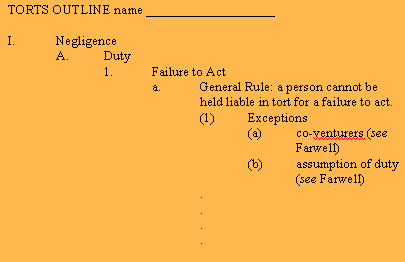U.S. Law School Information
Brought to you by NisiPrius.com
Case Briefing: The Four Step Process |
Step Four: Record What You've Learned, Including Professor's Comments |
| Law school students cover so much
material in a single day, it's hard to come back days or weeks later
and remember the structure and nuances of the law. That's why
you want to get your information recorded as soon as
possible. So you might set up a time every evening when you
spend an hour or so building your own outlines. During that time you would take the information from all of your various CBFS's and put it into your personal outline on the subject. So below is how your outline would read after having briefed and fleshed out the Farwell case and input the information into your outline:  Mixed into the outline would be comments made by the professor. You don't want the outline to become too wordy though. Even as staccato as the language above is, this outline would still likely go on for several dozen pages by the end of the semester. Further, you've cited to the case CBFS (by writing “see Farwell”), so if you've forgotten the concept by exam time, simply pull up the CBFS and the facts will refresh your memory. Also, purists might argue that Farwell only holds that co-venturers have an obligation to assist one another and does not cover assumption of duty; which is why Emanuels cites the Restatement of Torts (a cite in the middle of Emanuels p. 213) and not Farwell. There’s no point in your going into this sort of detail – your outline shows the correct rules of law. Further, on the exam you will not be writing down case names, so the point is moot. The bottom line is this: the Farwell case answers the lay questions: when do you have to help? If you do help, what quality of help must be given? |